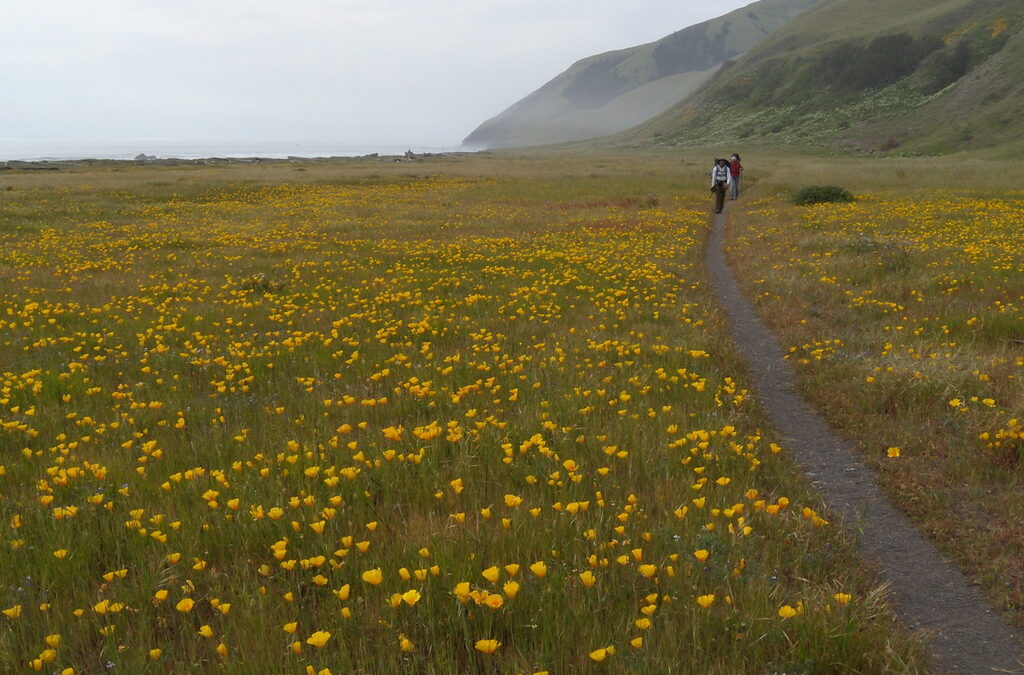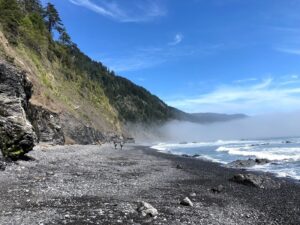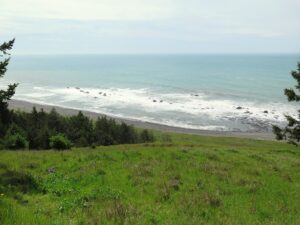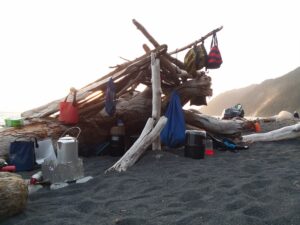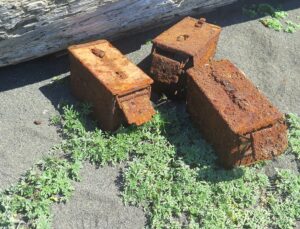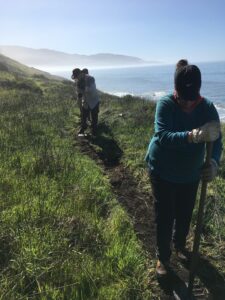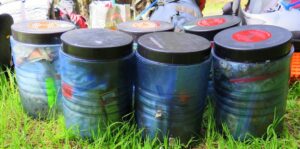2020 marks the 50th anniversary of the KRNCA, so we checked in with one of the KRNCA’s Backcountry Rangers (who also works alongside us in the field) to see what’s in store for this area and the Lost Coast Trail (LCT).
Thank you so much for taking the time for this interview. Could you please share your name, position and how long you’ve worked in the KRNCA?
My name is Deven Flaherty. I’m the Backcountry Ranger for the KRNCA. 2020 is going to be my sixth year working here.
How was 2019 for the LCT?
2019 was a spectacular year for the LCT. We had very heavy winter storms leading into the 2019 season, which helped wash away years of human impacts leaving a pristine, wild condition for any visitor on the Lost Coast.
Is this a common occurrence for your winters, or was this past winter an anomaly?
Yes and no. It is a common occurrence for us to have very heavy storms. We tend to see a lot of fluctuations throughout the winters and summers. Nature does help us out a lot with removing some of those impacts by wiping those beaches clean. This last one was a very, very heavy winter. It was historic level winter conditions. The LCT had around 200 inches of rain, and waves were clocked in at 40+ feet tall. They came up to levels that I haven’t seen in my time here and that some other long time locals haven’t seen in over 20 years. 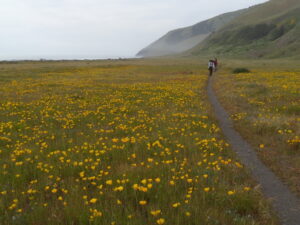 How was 2019 for the KRNCA?
How was 2019 for the KRNCA?
It was a very good year, overall, thanks to the efforts of not only our employees but to many volunteers and partners throughout our community. With their help, we managed to maintain damaged trails that were hit over that winter as I mentioned, remove several truckloads of marine garbage from the coast, and mitigate human impacts throughout the wilderness. We were also able to collect sufficient visitor data to evaluate the effectiveness of our new permit system which went into place in 2017.
For clarity on that, the permit system is now a reservation system with a visitor cap every day. During the busy parts of the year (May through September) we allow 60 people per day. In the winters we allow in 30 people per day. All permits must be acquired through Recreation.gov.
Regarding the permitting system, when did that come into place for the LCT/KRNCA?
So that officially started on January 1, 2017. Prior to that, all permits were self-registration at trailheads throughout King Range. People would show up, they would complete a permit themselves, and put it in the box. Then we rangers would collect those permits and that’s how we would get our usage data. However, the visitation numbers were getting much too high. This was due in part to travel publications and social media posts getting the word out about the King Range being such a fantastic destination. Everyone wanted to do the Lost Coast Trail. Those numbers grew every year for the course of about a decade. So the BLM decided to step in and come up with a new system that would keep visitation to a level more in line with the capacity of the landscape, while still providing opportunities for solitude to people who wanted to go out into the wilderness and have that primitive experience.
So it sounds like this is a successful program and that it’s staying.
It is, yes. Every year we’ve been taking a look at how it’s working and seeing if there are ways to adjust it to better suit the needs of the public and to better suit us being able to track how people are utilizing the landscape.
Touching back about what I said about collecting enough field data this year, we had a great crew of volunteer rangers who spent 10 weeks over the course of the summer backpacking the Lost Coast every week and talking to every visitor they encountered. They gathered data from a sample size of over 500 individuals and using that data we’ve been able to establish trends in what size groups have what attendance rate.
To expound a little upon that, we have a trend of “no-shows”. People make reservations for a group of 5 (which is the maximum permits that any one person can book), and more often than not they end up coming with less than 5 people. We’re worried that there are individuals missing out on the opportunity to experience the King Range due to permits being reserved but not used. This year we managed to really dig into that and find the rates at which different group sizes actually meet their attendance, which means we can be more targeted and effective in our solutions.
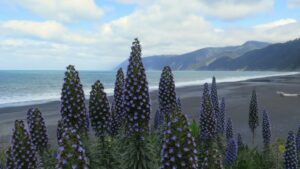 How’s 2020 coming along for KRNCA?
How’s 2020 coming along for KRNCA?
Well, so far, 2020 is shaping up to be a really special year for us. It’s actually the 50th anniversary of the King Range NCA. Throughout the entire year, we’re going to hold monthly events, those are going to include community outreach, volunteer activities, lecture series, guided interpretive hikes, all kinds of fun things. We’re doing at least 1 a month just for the anniversary and we’re pairing a lot of other ones around that. So we’re having 2-4 fun community events every month that people can come join in on and celebrate the King Range.
Do you have any sense of how this past winter has played out on the LCT, acknowledging that we’re still in it?
We’re having a little bit of a lighter winter than we did last year, it’s not of historic proportions; it’s more on par with what our average winters are. So I expect that to actually be a boon to King Range, or to the LCT specifically. Given as many benefits as came off last year’s large storm surge, there were also a lot of heavier impacts that had to be dealt with, such as large segments of lost or damaged trail. 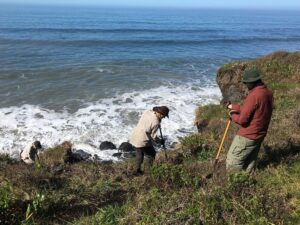 I think us having a lighter winter following that heavy one is kind of nice because we got a clean slate and managed to fix the trails that got most damaged. So this year, if we don’t lose those trails, we can focus our efforts on keeping the wilderness wild and unimpacted. I think so far this season is shaping up perfectly.
I think us having a lighter winter following that heavy one is kind of nice because we got a clean slate and managed to fix the trails that got most damaged. So this year, if we don’t lose those trails, we can focus our efforts on keeping the wilderness wild and unimpacted. I think so far this season is shaping up perfectly.
Do you or your department have any big goals you wish to accomplish this year for KRNCA?
Apart from the ongoing 50th Anniversary celebrations and engaging the public in that, we do have one big exciting project. We’re working with the State Coastal Conservancy in order to obtain a grant which we will use to expand upon accessible coastal camping facilities. The SCC would like to see more opportunities available for easy access to all demographics of people along the California coast. If this process goes smoothly and we obtain the grant, which looks promising right now, we’re going to use it to completely remodel the Mattole Campground.
Located at the very northern end of the KRNCA, the Mattole is our most iconic campground and our only beachfront campground. That remodel would not only improve the quality of the facilities already existing there but would also expand upon them. We’re looking to add between 5-8 new campsites within that campground. We would be able to accommodate at least an additional 40 campers per night with those new facilities. We’ll also be adding ADA compliant sites. We’re really trying to make this accessible to all demographics of users because it is a remote and beautiful place that everyone should have the opportunity to experience.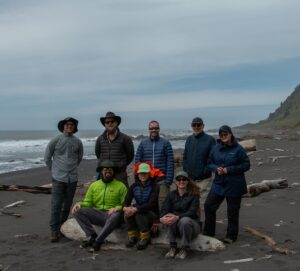 How many organizations do the KRNCA BLM partner with annually for stewardship projects?
How many organizations do the KRNCA BLM partner with annually for stewardship projects?
We have 12 core volunteer groups that we partner with every year. That includes yourself, Sierra Club, groups like that who actually come out and do backcountry work. We also have a great base of community organizations in our local area. We have very hands-on communities here, I think in part because they’re so small and remote, people have a real sense of being a part of what happens where they live. They want to be a part of the betterment of the surrounding landscape.
How do volunteer groups like Wilderness Volunteers help public land agencies, like yourself?
At our office, in particular, we’re a very small staff. Excluding seasonals, we only have 6 full-time employees covering 68,000 acres throughout the King Range. 43,000 of those are Wilderness, so completely inaccessible by vehicle. Only 2 of our 6 employees are field rangers, myself included. Essentially that means that 2 of us are responsible for the monitoring and care of the entire Wilderness.
When we have groups like yourselves, or other similar groups that come in, they make a monumental difference in preparing those lands for the use and enjoyment of the public. Last year we had over 1,200 hours of volunteer labor put in. To a staff like ours, that makes all the difference in the world as far as what we’re able to accomplish and how well we can fulfill our mission of maintaining a public good.
What’s your favorite area or part of the LCT? KRNCA?
Most people when they think of the King Range, they think immediately of the LCT. I put some thought into this personally and I have to say my favorite spot is the King Crest Trail, which follows the ridge of the mountains above the LCT. It’s such a unique location; it feels like you’re straddling the precipice between two worlds when you’re up there. You’re basically on top of the world because you’re on the tallest mountain range for miles around, so you can see in a 360° panorama from many points.
Being that the King Range has such steep slopes, you’re walking along the spine of a mountain that on one side seems to drop straight to the Pacific Ocean thousands of feet below you, and on the other side it extends inland into a sea of rolling prairies and river valleys. It’s an amazing experience being up there atop the divide between two of the starkly diverse strata that California has to offer.
To clarify, the King Crest Trail falls within the KRNCA permitting system?
Yes, it does. That is within the King Range Wilderness.
What would you say to a first-time participant on a stewardship project in the KRNCA?
I would say you’re in for a wild, rugged, and scenic adventure like no other in the country. Be prepared for anything. My personal advice: BRING EXTRA SOCKS.
How can people be better recreators when visiting KRNCA?
I encourage people to familiarize themselves with the principles of Leave No Trace and then practice those principles during your time here. On top of that, look into the unique principles for the particular landscape you’re visiting. Often agencies will have guidelines specific to the needs of that landscape.
On the Lost Coast, since we’re such a locked-in landmass with cliffs on one side and ocean on the other, there’s not much open space. Most people don’t know where they’re going to go to the bathroom. Our unique LNT principle is asking people to actually go to the bathroom down in the wet sand section along the beach. This isn’t an ethic usually taught in other situations; your instinct is to get away from the water (which is typically a good thing). So I would definitely say looking into and adhering to the LNT ethics and practices for the particular landscape you’re going to visit is the way to be the best recreator you can be.
How can people be better hikers when hiking the LCT?
As I mentioned in the prior question, the Lost Coast is such a narrow landmass that there’s not much space for people to sprawl out along it. The best thing people could do is confine their actual activities and travel to the beach itself where possible, rather than using coastal bluffs or vegetated areas. We have the unique natural gift here of the ocean, that literally washes away human impacts on the sandy stretches of the coast. Since we have a lot of people utilizing this very slim landmass, the best way to be an ethical hiker out there is to maintain your activities on an area where nature will wipe itself clean for the next visitor.
What’s a common misstep you see or hear about with those who visit KRNCA? Those hiking the LCT?
Never underestimate the terrain, first and foremost. Secondly, never overestimate your own abilities.
The ocean here is not to be trifled with. So I always tell people to practice the utmost caution when traversing the impassable zones. The distance that you’re normally going to cover in your other hiking activities will not be reflected that same way when hiking along the Lost Coast. The terrain is rugged, remote and unforgiving. The sand absorbs your kinetic energy, slowing you down and wearing you out at a much faster rate than compacted trails. So it can literally be a matter of life or death if you overestimate yourself or underestimate the ocean and those intertidal zones. 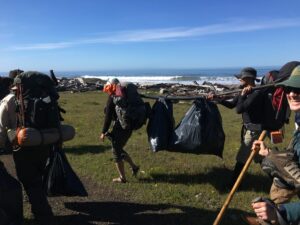 Do you have any stats you could share about the amount of trash removed from the KRNCA in 2019?
Do you have any stats you could share about the amount of trash removed from the KRNCA in 2019?
Yes, approximately 1,500 lbs of combined visitor trash and marine debris were removed from the King Range Wilderness.
What’re the craziest found objects you’ve seen in the KRNCA?
Ooooh, that is a tough question. First: historic shipwrecks. Near Spanish Flat, we found the actual body of an old ship. In the winter when the sand begins to erode, you’ll see the large metal sections of it sticking up. Near the Punta Gorda lighthouse, there is a propeller which was a part of a ship that went down in the 1800s. It even has the date and name of the ship stamped in.
Second to that would be native village sites and burial grounds. There is some really unique and fascinating cultural history out here. Third would be what I call “doomsday caches”. People have buried ammo boxes full of various supplies and things throughout the backcountry. I suppose this is so if anything ever “went down”, they could retreat into the wilderness. When they bury them on the coast, especially when the face of the beach changes, we will come across these boxes in varying states of rust and decay. We of course remove them, but I enjoy thinking of them like time capsules: you know every cache must have a unique backstory, and you never know what will be inside.
Are there any major reroutes in store for the LCT based on erosion/natural phenomena?
Yes, two large ones that occurred over that heavy winter at the beginning of 2019 were near the Cooskie Spur at the north end of the LCT, and Miller Flat at the southern end, near the southern impassable zone. Those are two sections that we didn’t have the ability to get out and completely reroute this past year. Moving forward this year, we’re going to sure up those trails and make that safe again.
What’s the craziest thing you saw in 2019 in the KRNCA?
Watching coyotes stalk deer down to the coast and watching the deer inevitably jump into the ocean in a last-ditch effort to getaway. I’ve watched coyote chase deer down into the surf and the deer will swim out into the ocean and then wait until the coyote gives up.
How did that play out?
This last one, the deer ended up having to stay out past the wave break, it probably swam 100 yards out in a panic, and it stayed out there for about 5 minutes treading water while the coyote paced the beach. The coyote finally gave up and headed south, and then the deer came back onto the shore and collapsed in the shore break and slept or laid there for about 15 minutes getting splashed by waves until it regained enough strength to head back into the mountains.
What behaviors can people practice in their day-to-day lives to positively impact coastal gems like the KRNCA?
I would say being conscientious of what you share on social media platforms. I encourage people, of course, to share their experiences and I understand the impulse to have experienced joy in a natural place and want others to have that same joy, but the conscientious side of that is to include the ethics of how you got there.
For example, if you had to go through a certain permitting process, or if you know the regulations or LNT Principles for an area, include those along with the experience you have so that others following in your footsteps can make sure to behave ethically as well. This way, everyone gets to have the same joyful experience.
What’s the coolest animal or plant you’ve actually seen (dead or alive) in the KRNCA?
I’m going to go animal and it would be a Baird’s Beaked Whale. One of them washed ashore in 2016. They’re a very rare species to my understanding, and it piqued the interest of the local scientific community. The BLM and Humboldt State University paired together and they actually went out to study the remains. I got to participate in a field dissection of that whale. We measured the specimen, we took tissue samples, and we ended up removing the skull which is now at HSU being used for study under the marine mammal program. The fun fact about this one is that this particular Baird’s Beaked Whale turned out to be just shy of the world record in size for that species.
Were they able to determine a cause of death for this particular whale?
I believe it was natural causes. Through the dissection, to my knowledge, they didn’t find trash in its stomach or anything of that nature.
You’re out on a 7-day backcountry hitch. What do you pack for yourself as a treat?
I think most people would say a particular snack, but for me, Kava Tea. It is a natural stress reducer and muscle relaxer and thus it’s excellent for soothing your sore body during a long haul in the wilderness. It also helps you get a good night’s sleep, which can make all the difference during your extended trek.
With such direct coastal access and the amount of varied debris that washes up on shores, are there any correlations you’ve made to inland humanity? Anything that stunned you? 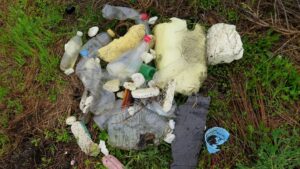
We sure do get a lot of very unique items washing up in the form of marine debris. Anything from car parts, to home appliances, to fishing supplies- you name it. There are things that are definitely not coastal specific, fishing supplies are a good example of what you’d expect to find on the coast, whereas a refrigerator or culvert or random objects like that, you wouldn’t. But what I’ve noticed, more than what inland communities specifically are sending out, it’s what global communities are sending out. I find trash from all over the world. It’s fascinating to take pictures of the languages that are found on these objects and try to track it down. We find stuff Asia, South America, just all over. It’s really an eye-opener to see exactly how connected the entire globe is with what we create and what we put out there. When you throw something away, there is no “away”.
Can you leave us with one fun fact about KRNCA or the LCT?
Nearly 99% of visitors to the KRNCA utilize the LCT specifically, yet the usable acreage of the LCT only accounts for 1.5% of the total acreage in the KRNCA. So essentially, about 99% of people use the same 1% of the landmass over and over again.
I appreciate your time and answers! We’re really looking forward to working with you this year and celebrating KRNCA’s 50th through stewardship.
If you’re interested in joining this 2020 project, check out the project page and contact our office with your questions. It’s a fabulous project in a truly remote and rugged wilderness.
The views, information and opinions expressed in this interview are those of the individuals involved and do not necessarily reflect the official policy or position of any other agency, organization, employer or company.
The appearance of hyperlinks on this blog does not constitute endorsement by Wilderness Volunteers of the linked site or the information, products or services contained therein.
Mention of any specific commercial products, process, or service by trade name, trademark, manufacturer, or otherwise does not necessarily constitute or imply its endorsement by Wilderness Volunteers.

